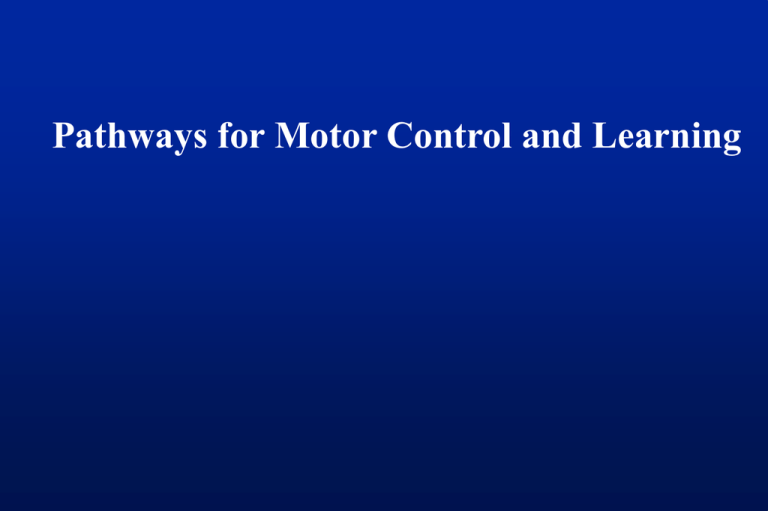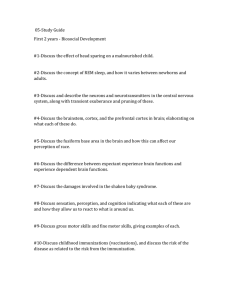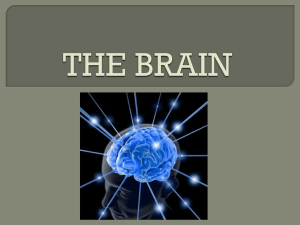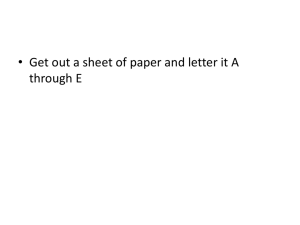Pathways for Motor Control and Learning
advertisement

Pathways for Motor Control and Learning Spinal Cord: The stretch reflex Maintain stability Spinal Cord: The stretch reflex Maintain stability But modifiable: State dependent e.g., gait, sharpshooter Spinal Cord: The stretch reflex Maintain stability But modifiable: State dependent Movement as change between postural states. Reflex-like behavior in the right anatomy…. Complex behavior Reflex-like behavior in the right anatomy…. Complex behavior Central Pattern Generators Evolutionary Learning Rapid modification of “ancient” CPG http://www.nature.com/neuro/journal/v10/n8/extref/nn1930-S1.mov Split-belt Choi and Bastian, 2007 Rapid modification of “ancient” CPG Stance Phase Grey: Fast leg Black: Slow leg Context-specific adaptation Choi and Bastian, 2007 Rapid modification of “ancient” CPG Hybrid walking: One leg forward and one leg backward http://www.nature.com/neuro/journal/v10/n8/extref/nn1930-S5.mov Split-belt Choi and Bastian, 2007 Descending Signals: Extrapyramidal Pathways Integration of other sensory signals with spinal mechanisms. Subcortical Characters: The Cerebellum Multisensory (and other) inputs Descending and ascending output Subcortical Characters: The Basal Ganglia Components of the Basal Ganglia Striatum Globus Pallidus Subthalamic nucleus Substantia nigra Anatomical features: Multisensory/associative input Complex internal circuitry Restricted output Replication of circuitry The Cortex: Primary Motor Cortex Motor Cortex Pyramidal Tract (corticospinal) 90% Crossed; 10% Uncrossed Project to motor neurons and spinal interneurons Origin in M1, premotor, postcentral Internal capsule The Cortex: Secondary Motor Areas Premotor Cortex Supplementary Motor Area (SMA) The Cortex: Association “Motor” Areas (take that vision chauvinists) Pre-SMA Views on hierarchical organization 1. Degree of sensory integration Spinal mechanisms: Limited to somatosensory Cortex: Polysensory Views on hierarchical organization 1. Degree of sensory integration Spinal mechanisms: Limited to somatosensory Cortex: Polysensory 2. Flexibility: Contextualization of Action Exploiting degrees of freedom Views on hierarchical organization 1. Degree of sensory integration Spinal mechanisms: Limited to somatosensory Cortex: Polysensory 2. Flexibility: Contextualization of Action Exploiting degrees of freedom 3. Abstraction of control Goal > Action > Movement e.g., reaching for coffee cup Views on hierarchical organization 1. Degree of sensory integration Spinal mechanisms: Limited to somatosensory Cortex: Polysensory 2. Flexibility: Contextualization of Action Exploiting degrees of freedom 3. Abstraction of control Goal > Action > Movement e.g., reaching for coffee cup 4. Other ??? Motor Learning Three paradigms: Force field learning A: Baseline (null field) B. Force Field C. Initial Perf. D. Late Perf. E. Generated forces, late After-effect in null field Motor Learning Three paradigms: Force field learning Visuomotor transformations DEMO Motor Learning Three paradigms: Force field learning Visuomotor transformations examples: displacements, rotations, inversions, reversals (mirror drawing), depth distortions Motor Learning Three paradigms: Force field learning Visuomotor transformations Sequence learning Serial Reaction Time Task Press response key corresponding to stimulus position. Stimuli follow sequence or are chosen at random. Motor Learning Three paradigms Force field adaptation Visuomotor transformations Sequence learning Does one term (motor learning) fit all? How to determine similarities/differences? Motor Learning S&W’s (anti)definition: Adaptation vs. Skills Adaptation: Retuning of existing competence. “Regain capabilities in altered circumstances.” Skill: “Expansion of motor repertoire.” Force field: Adaptation Sequence learning: Skill Visuomotor transformation: ??? Acquisition: error type? on-line vs. knowledge of results sensory vs. symbolic? rate of learning? Acquisition: error type? rate of learning? Generalization local or general? transfer? SRT is symmetric Force field is better right to left VMT may be better left to right (?) Acquisition: error type? rate of learning? Generalization local or general? transfer? Consolidation: Stability over time? Does learning related task interfere with initial learning? Would this be characteristic of skill or adaptation? Consolidation in force field learning: B1: Initial force field B2: Second force field, learning after delay (consolidation phase) Time-dependent consolidation. Always some interference from B2. Is “control” correct term? Note that in control, there is an intervening force field– the null field of everyday life. Motor Learning Three paradigms Force field adaptation Visuomotor transformations Sequence learning Neural systems: Do these tasks engage common regions?





